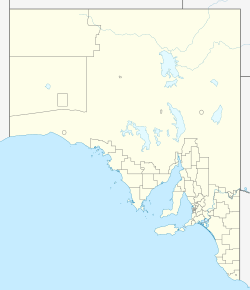Nicolas Baudin Island facts for kids
| Geography | |
|---|---|
| Location | Great Australian Bight |
| Coordinates | 33°00′58″S 134°07′50″E / 33.01608°S 134.13054°E |
| Area | 10 ha (25 acres) |
| Administration | |
|
Australia
|
|
| Demographics | |
| Population | 0 |
Nicolas Baudin Island is a small island in South Australia. It is located about 500 meters (1,640 feet) west of Cape Blanche. This is on the west coast of the Eyre Peninsula. The island is also about 25 kilometers (15.5 miles) southwest of the town of Streaky Bay.
Nicolas Baudin Island is very important because it is a special breeding place for Australian sea lions. Since 2003, the island and its nearby waters have been a protected area. This means it is part of the Nicolas Baudin Island Conservation Park. This helps keep the sea lions safe.
Contents
About Nicolas Baudin Island
Nicolas Baudin Island is found off the coast of South Australia. It is about 500 meters (1,640 feet) from Cape Blanche. This cape is on the western side of the Eyre Peninsula. The island is also about 25 kilometers (15.5 miles) southwest of Streaky Bay.
The island covers an area of about 10 hectares (25 acres). It is surrounded by reefs on most sides. The island is made up of large, reddish-brown granite rocks. It also has sandy spots and small pools of water that fill up at high tide. Most of the island is quite low. Some parts even get covered by water during high tide.
To protect the Australian sea lions, people are not allowed to visit the island. They also cannot go into the waters right around it. This rule has been in place since January 2003.
How the Island Formed
Nicolas Baudin Island was formed a very long time ago. This happened between 6,000 and 7,700 years ago. It appeared after sea levels rose at the start of the Holocene period. The island's main rock is a type of granite. This granite is part of a very old rock base called the Gawler Craton.
The water around the island is quite deep. On the north side, the water is at least 15 meters (49 feet) deep. On the west side, it drops to about 20 meters (66 feet) deep. The seabed continues to get deeper further out. It reaches 50 meters (164 feet) about 2.2 kilometers (1.4 miles) west of the island.
Animals and Plants
Surveys on Nicolas Baudin Island have looked at the animals living there. These surveys mainly focused on sea mammals like sea lions and seals, and also on birds.
Plants on the Island
As of 2007, there were no land plants reported on Nicolas Baudin Island. This means the island is mostly bare rock and sand.
Sea Lions and Seals
The island is a very important place for Australian sea lions. It is a rookery, which means it's where they come to breed and raise their pups. New Zealand fur seals also use the island. They come there to rest on the land, which is called a haul out site.
Birds on the Island
Bird surveys were done between 2002 and 2005. They found that Pacific gulls and sooty oystercatchers breed on the island. Many other bird species also use the island as a resting spot. These include:
- little penguin
- short-tailed shearwater
- Australasian gannet
- little pied cormorant
- black-faced cormorant
- pied cormorant
- little black cormorant
- great cormorant
- Australian pelican
- white-faced heron
- silver gull
- caspian tern
- crested tern
Island History
European Discovery and Naming
Nicolas Baudin Island was not found by early explorers like Matthew Flinders or Nicolas Baudin. It was likely identified later during surveys by the Government of South Australia. These surveys happened after 1836 when people started settling in the area. They needed to map the waters and coastlines.
The island was first known informally as Cape Blanche Island. In 2002, a public competition was held to choose a new name. This was part of the plan to make the island a conservation park. The name "Nicolas Baudin Island" was chosen. It became official in May 2003, after the conservation park was created in January 2003.
People also fish for greenlip abalone near the island. This is done by divers. As of 2006, licensed fishing is allowed within the Nicolas Baudin Island Conservation Park. However, it is only permitted when the Australian sea lions are not breeding. This helps protect the sea lions during their important breeding season.
Protected Status
Nicolas Baudin Island became a protected area on January 16, 2003. This happened under the National Parks and Wildlife Act 1972. The protection includes both the island itself and the waters around it. These waters extend beyond the low water mark. The waters near the island are also part of a special sanctuary zone within the West Coast Bays Marine Park. This means they are extra protected.


